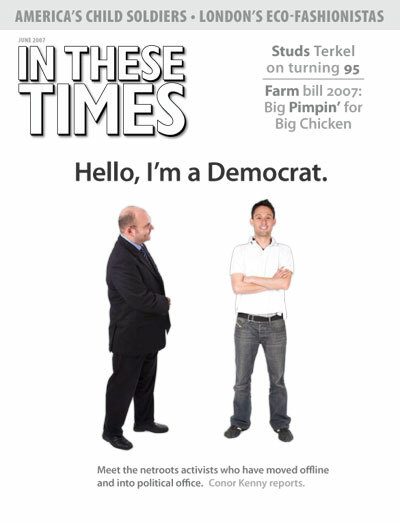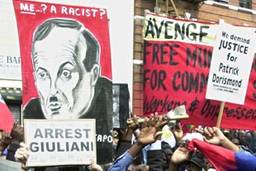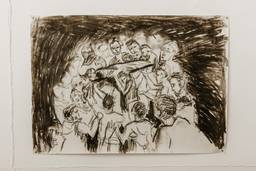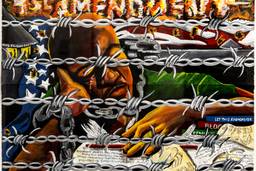Developmentalism in the Big Apple
Cost of living has skyrocketed in New York, but under fatcats Giuliani and Bloomberg, the working man’s wage has not
Steven Wishnia
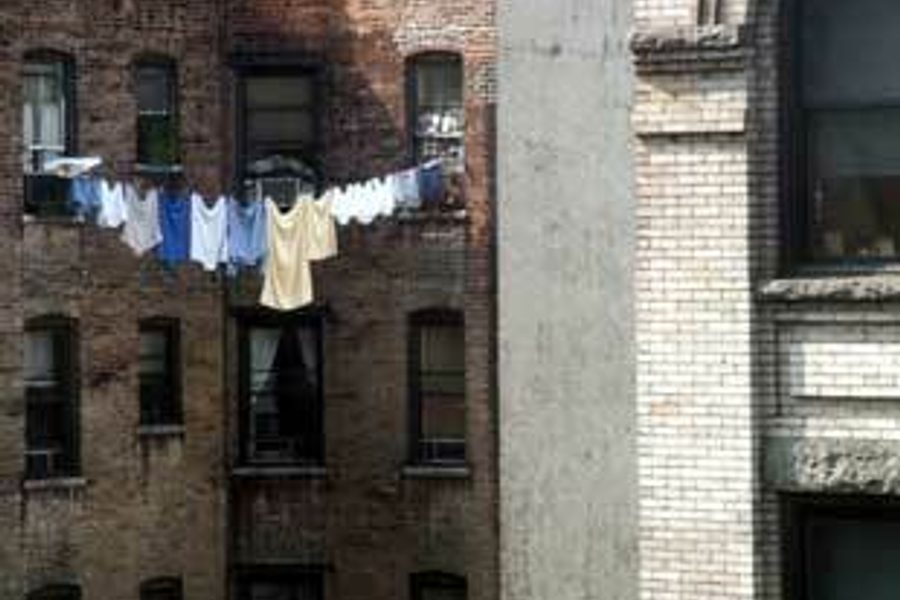
Thirty years ago, you could easily find a one-bedroom apartment in a middle-class neighborhood in New York City for $150 a month. Today, it would cost more than $1,500 – more than what Yankees slugger Reggie Jackson, then baseball’s highest-paid player, paid in 1977. His Fifth Avenue apartment with a balcony overlooking Central Park cost $1,466 a month. And the minimum wage hasn’t gone up to $27.82 an hour.
How we got to this point is the subject of Kim Moody’s From Welfare State to Real Estate: Regime Change in New York City, 1974 to the Present (The New Press). Moody analyzes how New York’s business elite exploited the ’70s fiscal crisis to destroy the city’s “social-democratic polity” and impose the neoliberal agenda that has dictated “restraint on social spending, privatization, deregulation, and most importantly, the reassertion of class power by the nation’s capitalist class.”
The result is a city where inequality has grown to extremes far beyond those in the rest of the country, where a small but growing cabal of the spectacularly rich uses government as a vending machine and lords it over a hollowed-out middle class and millions of low-paid, increasingly immigrant service workers. Moody, a cofounder of Labor Notes, lays this out lucidly and in detail. For those who love New York, reading it is both enlightening and infuriating, like a true-crime book where you know the victim.
The conventional wisdom is that the 1975 fiscal crisis was caused by profligate liberal policies: the expansion of social services in the ’60s and the costs of supporting the largest public-service infrastructure of any U.S. city, with 22 public hospitals, a free university system and the biggest subway system in the world. Moody points out that spending growth in those areas had slowed dramatically since the ’60s, while the cost of interest on the city’s debt was mushrooming. He posits that eliminating tax abatements for corporate construction could have done a lot to avert the crisis. That explanation feels a bit thin – the deeper structural cause was the city’s massive deindustrialization. Moody notes that New York lost an astounding 600,000 industrial jobs between 1968 and 1977. That eliminated the working-class prosperity that was the economic and political base for supporting such a public infrastructure. It also eliminated the traditional source of legitimate income in the city’s poorer neighborhoods.
Scared by what would happen if the city went bankrupt, local labor unions largely collaborated with the elite agenda of layoffs and service cuts. The transformation into an economy dominated by finance restored the city’s overall wealth, but the distribution of it became grossly unequal. And with labor having tacitly assented to this state of affairs, city politics for the next 25 years would be dominated by racial appeals. White voters elected mayors Ed Koch and Rudy Giuliani, who campaigned and governed on thinly coded law-and-order slogans. David Dinkins, the city’s one-term (1990−93) black mayor, symbolically evoked diversity more than he challenged the elite agenda. Moody notes that the teachers union refused to endorse him for re-election; the reason was that Dinkins had promised them a token pay raise and reneged on it after the city’s establishment objected.
Current Mayor Michael Bloomberg is often called a liberal – in these devalued times when merely not being psychotic about other people’s sex lives is enough to qualify – but he’s actually a devout plutocrat. He’s not as pugnacious as Giuliani (though he has similar contempt for civil liberties), but his role requires different character traits. Giuliani’s task was to put the “ungovernable” racial elements in their place; Bloomberg’s is to enable the rich to make cauldrons of money. Moody terms the mayor’s philosophy “developmentalism”: packing the skyline with luxury high-rises and handing out more than $3 billion a year in tax breaks to corporations and upscale housing, while rapidly rising numbers of working-class New Yorkers pay more than half their income in rent. During this real-estate boom, Moody notes, not only have levies on working people – income and sales taxes – surpassed property taxes as a source of city revenue, but the property-tax system is so skewed that the owner of a two-family house in a lower-middle-class black neighborhood near Kennedy Airport pays almost three times the percentage of market value charged on a 12-room Park Avenue co-op.
Bloomberg has made some grand-sounding promises about building affordable housing, but Moody dissects the formulas used to determine what’s deemed “affordable.” Based on the median income for the metropolitan area, apartments that go for as much as $1,800 a month are classified as “middle income,” such as those in the planned Atlantic Yards sports arena/housing complex in Brooklyn. And both the mayor and Gov. Eliot Spitzer, a Democrat, oppose restoring the city’s home rule over its rent-control laws. Moody doesn’t go into much history on this, but the 1971 state law that banned the city from enacting any rent restrictions stronger than the state’s was a harbinger of the neoliberal agenda. It put power over the rent laws in the hands of upstate and suburban Republicans whose strongest connection to the city is the money they take from its landlords. When they gutted the rent-stabilization laws in 1997, and when former Gov. George Pataki virtually eliminated enforcement against illegally high rents, the city government was powerless to stop it.
Against all this, Moody posits the possibility that some new activist coalition, growing out of the city’s one million rank-and-file union members, community-labor organizations such as Brooklyn’s Make the Road By Walking, and tenant and anti-gentrification groups, will emerge to battle neoliberalism. It’s a thin hope so far, but an essential one.
One promising recent trend has been the emergence of organizing against “environmental racism,” the practice of placing incinerators in working-class and poor Latino and black neighborhoods that were already polluted. As one city official told me in the early ’90s when I was covering the campaign against a 55-story incinerator proposed for the Brooklyn Navy Yard: “Where should we put it? On Fifth Avenue?”
Julie Sze’s Noxious New York: The Racial Politics of Urban Health and Environmental Justice (MIT Press) analyzes how organizers in four such targeted neighborhoods synthesized environmental concerns with class and race issues. They also developed novel tactics, such as the “Earth Crew,” teenagers who worked with the Columbia School of Public Health to measure soot and particulate pollution at four intersections near a West Harlem bus depot; activists used the data to persuade the city to convert the buses there to hybrid vehicles.
Two principles emerged from the movement. One was a focus on the cumulative effects of neighborhood pollution. In the South Bronx, where 40 percent of the children in some schools had asthma, activists protested that a proposed medical-waste incinerator would only make this worse. And when Giuliani closed the legendarily pungent Fresh Kills landfill in Staten Island in 1996, planning to privatize garbage disposal and truck the city’s waste to other states, a key criticism was that the plan would pour diesel exhaust into the air of Williamsburg and the South Bronx, which held most of the city’s waste-transfer stations. The other was the “precautionary” principle, that potential polluters be required to prove that their operations will be safe, instead of the community having to prove direct harm.
Sze weaves in intriguing bits of history throughout the book, such as noting that in the early 20th century, 80 percent of U.S. cities required recycling organic waste and coal ashes. But her writing often belabors the obvious. Describing an environmentalist coalition’s flyer that depicted Gov. Pataki and a black kid with an asthma inhaler, Sze writes, “This visual contrast of the state’s most powerful politician with a child of color with asthma is a literal representation of [the group’s] essential politics and belief systems.” Since the records of environmental-justice campaigns have been mixed, the book would also have benefited from more voices from organizers and the communities involved, assessing which strategies worked, which didn’t and what more is needed.
We desperately need that kind of organizing savvy, particularly in the face of, as these two books clearly demonstrate, neoliberalism’s toxic blend of economic oppression and environmental ravages.
